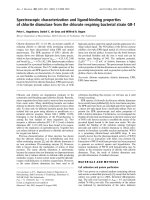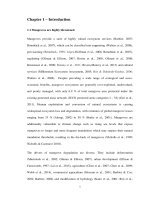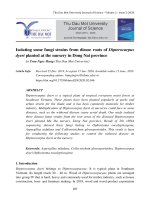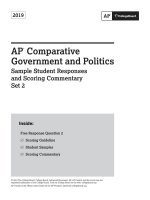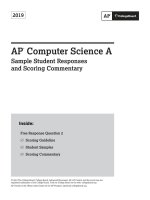Nitrogen-containing heterocyclic compounds from the roots of Callerya speciosa
Bạn đang xem bản rút gọn của tài liệu. Xem và tải ngay bản đầy đủ của tài liệu tại đây (927.39 KB, 4 trang )
Life Sciences | Pharmacology
Doi: 10.31276/VJSTE.64(3).49-52
Nitrogen-containing heterocyclic compounds
from the roots of Callerya speciosa
Duc Thien Dao1, Quoc Thang Le2, Thanh Tam Nguyen1, 3*
Institute of Chemistry, Vietnam Academy of Science and Technology
2
Department of Chemistry, Hue University of Education
3
Graduate University of Science and Technology, Vietnam Academy of Science and Technology
1
Received 30 October 2021; accepted 29 November 2021
Abstract:
The four nitrogen-containing heterocyclic compounds uridine (1), 2-(β-D-glucopyranosyl)-3-isoxazolin-5one (2), adenosine (3), and hypaphorine (4) were isolated from the n-butanol extract of the roots of Callerya
speciosa. Their structures were characterized on the basis of extensive nuclear magnetic resonane (NMR),
mass spectroscopic analyses, and comparison with reported values. This is the first report on the isolation of
compounds 1-4 from Callerya speciosa.
Keywords: Callerya speciosa, Leguminosae, nitrogen-containing heterocyclic compounds.
Classification number: 3.3
Introduction
Materials and methods
Callerya speciosa (Champ.) Schot. [synonym:
Millettia speciosa Champ.] is a valuable medicinal plant
belonging to the family Leguminosae, which is widely
distributed in Southeast Asia in the tropical and subtropical
forests of Hainan Island and southern mainland China [1].
C. speciosa is also found in the north areas of Vietnam
such as Tuyen Quang, Bac Kan, Bac Giang, and Phu
Tho. In recent years, C. speciosa has been planted more
frequently in areas of Vietnam as its roots have been used
as a traditional medicine for the treatment of fever, cough,
headache, backache, rheumatism, chronic bronchitis,
and nephritis [2]. Previous phytochemical studies on
this species revealed the presence of phenolics, phenolic
glycosides, pterocarpans, flavonoids, isoflavonoids,
sterols, and chromones [3-9]. In a previous work, we
reported the isolation and structural characterization of a new
oleanane triterpenoid along with three known compounds
from the ethyl acetate extract of the C. speciosa roots
[10]. In a further investigation of chemical constituents
from the n-butanol extract of the roots of this species, we
isolated four nitrogen-containing compounds including
uridine (1), 2-(β-D-glucopyranosyl)-3-isoxazolin-5one (2), adenosine (3), and hypaphorine (4), and their
structures were fully characterized.
General experiment procedure
1D- and 2D-NMR spectra were acquired on a Bruker
Avance 500 Ultrashield NMR Spectrometer. ESI-MS was
measured on an Agilent LC-MSD-Trap SL. Thin layer
chromatography was carried on silica gel 60 F254 (0.25
mm, Merck) and reversed phase RP18 F254S (0.25 mm,
Merck) plates. Column chromatography was performed
using silica gel 60 (230-400 mesh, Merck), YMC RP18 resins (30-50 μm, Fuji Silysia Chemical Ltd), and
Sephadex LH-20 gel (Amersham Pharmacia Biotech).
Plant material
The plant material was collected in the Tan Yen
district, Bac Giang province, in March of 2018. The
sample identification was done by Dr. Nguyen The
Cuong, Institute of Ecology and Biological Resources,
Vietnam Academy of Science and Technology (VAST),
and a voucher specimen was preserved in the Laboratory
of Natural Products Research, Institute of Chemistry,
VAST.
Extraction and isolation
The powdered roots of C. speciosa (870 g) were
extracted with 95% methanol three times at room
temperature. The extracts were filtered, combined, and
Corresponding author: E-mail:
*
september 2022 • Volume 64 Number 3
49
Life Sciences | Pharmacology
concentrated under reduced pressure. The obtained
residue was successively dissolved with water and reextracted in turn with ethyl acetate and n-butanol. The
organic solvents were concentrated to give 4.6 g and 9.7
g of the corresponding extracts.
The n-butanol extract was fractionated by silica gel
column chromatography eluted with CH2Cl2:MeOH:H2O
(4:1:0.1 - 1.5:1:0.2, v/v) to give 7 fractions. Fraction 2
was re-purified by silica gel column (CH2Cl2:MeOH:H2O
= 4:0.8:0.1, v/v), then Sephadex LH-20 column (MeOH)
to afford compound 1 (4 mg). Fraction 4 was re-purified
on a silica gel column (CH2Cl2:MeOH:H2O = 3:1:0.1,
v/v), then Sephadex LH-20 column (MeOH) to give
compounds 2 (3 mg) and 3 (4 mg). Fraction 6 was
chromatographed on a reversed phase silica gel (RP18) column (MeOH:H2O = 1:1), then silica gel column
(CH2Cl2:MeOH:H2O = 2.5:1:0.1, v/v) to yield compound 4
(7 mg).
Uridine (1):
Yellowish solid. ESI-MS: m/z267.2 [M+Na]+.
H-NMR (500 MHz, CD3OD): δH 8.02 (1H, d, J=7.0 Hz,
H-6), 5.92 (1H, d, J=4.0 Hz, H-1′), 5.71 (1H, d, J=7.0 Hz,
H-5), 4.21-4.19 (1H, m, H-2′), 4.18-4.16 (1H, m, H-3′),
4.03-4.02 (1H, m, H-4′), 3.86 (1H, dd, J=10.0, 2.0 Hz,
H-5a′), 3.75 (1H, dd, J=10.0, 2.0 Hz, H-5b′). 13C-NMR
(125 MHz, CD3OD): δC166.19 (C-4), 152.47 (C-2),
142.73 (C-6), 102.66 (C-5), 90.75 (C-1′), 86.37 (C-4′),
75.72 (C-2′), 71.31 (C-3′), 62.28 (C-5′).
1
2-(β-D-glucopyranosyl)-3-isoxazolin-5-one (2):
Colourless solid. ESI-MS: m/z248.1 [M+H]+.
H-NMR (500 MHz, CD3OD): δH 8.44 (1H, d, J=3.0 Hz,
H-3), 5.33 (1H, d, J=3.0 Hz, H-4), 4.92 (1H, d, J=7.5
Hz, H-1′), 3.87-3.85 (1H, m, H- H-6a′), 3.69-3.67 (1H,
m, H-6b′), 3.61-3.60 (1H, m, H-2′), 3.46 (1H, t, J=7.5
Hz, H-3′), 3.41-3.40 (1H, m, H-5′), 3.36 (1H, d, J=7.5
Hz, H-4′). 13C-NMR (125 MHz, CD3OD): δC 173.96 (C5), 154.73 (C-3), 90.86 (C-4), 90.43 (C-1′), 80.39 (C-5′),
78.67 (C-3′), 73.85 (C-2′), 70.93 (C-4′), 62.46 (C-6′).
1
Adenosine (3):
White solid. ESI-MS: m/z 268.1 [M+H]+. 1H-NMR
(500 MHz, CD3OD): δH 8.32 (1H, s, H-8), 8.20 (1H, s,
H-2), 5.99 (1H, d, J=6.5 Hz, H-1′), 4.76 (1H, dd, J=6.0,
5.5 Hz, H-2′), 4.35 (1H, dd, J=5.0, 3.0 Hz, H-3′), 4.19 (1H,
dd, J=3.5, 3.0 Hz, H-4′), 3.91 (1H, dd, J=12.5, 3.0 Hz,
H-5a′), 3.77 (1H, dd, J=12.5, 3.0 Hz, H-5b′). 13C-NMR
(125 MHz, CD3OD): δC 157.41 (C-6), 153.52 (C-2),
150.02 (C-4), 142.01 (C-8), 121.24 (C-5), 91.26 (C-1′),
88.17 (C-4′), 75.48 (C-2′), 72.65 (C-3′), 63.47 (C-5′).
50
Hypaphorine (4):
Colourless solid. ESI-MS: m/z 247.3 [M+H]+.
1
H-NMR (500 MHz, CD3OD): δH 7.67 (1H, dd, J=6.5,
1.0 Hz, H-5), 7.39 (1H, dd, J=6.5, 1.0 Hz, H-8), 7.23
(1H, s, H-2), 7.15 (1H, dt, J=6.0, 1.0 Hz, H-7), 7.09 (1H,
dt, J=6.0, 1.0 Hz, H-6), 3.91 (1H, t, J=6.0 Hz, H-11),
3.44 (2H, d, J=6.0 Hz, H-10), 3.29 [9H, s, -N+(CH3)3].
13
C-NMR (125 MHz, CD3OD): δC 171.34 (C-12), 137.98
(C-9), 128.37 (C-4), 125.16 (C-2), 122.63 (C-7), 120.07
(C-6), 119.22 (C-5), 112.55 (C-8), 109.21 (C-3), 80.58
(C-11), 52.73, 52.71, 52.69 [-N+(CH3)3], 24.62 (C-10).
Results and discussion
Compound 1 was obtained as yellowish solid. The
C-NMR and HSQC spectra of compound 1 revealed
resonances for nine carbons of which four carbons
[δC 166.19 (C-4), 152.47 (C-2), 142.73 (C-6), 102.66
(C-5)] were assigned to a uracil and five carbons [δC
90.75 (C-1′), 86.37 (C-4′), 75.72 (C-2′), 71.31 (C-3′),
62.28 (C-5′)] to a ribofuranosyl unit. The 1H-NMR
spectrum showed signals of a pair of doublets at δH 8.02
(1H, d, J=7.0 Hz, H-6) and 5.71 (1H, d, J=7.0 Hz, H-5);
a ribofuranose with an anomeric proton signal at δH
5.92 (1H, d, J=4.0 Hz, H-1′); and other sugar protons in
regions δH 4.21-3.75 ppm. The HMBC spectrum showed
correlations from H-1′ (δH 5.92) to C-2 (δC 152.47) and
C-6 (δC 142.73) indicating uracil linked to a ribofuranose
via a β-N1-glycosidic bond. The molecular formula
of 1 was deduced to be C9H12N2O6 based on NMR data
and an ESI-MS pseudo-molecular ion peak at m/z 267.2
[M+Na]+. The 1H- and 13C-NMR data from compound 1
were consistent with uridine in literature [11]. Therefore,
compound 1 was elucidated to be uridine.
13
Compound 2 was isolated as colourless solid. The
H-NMR spectrum of compound 2 shows typical signals
of isoxazolin-5-one with two doublets of H-3 and H-4
at δH 8.44 and 5.33, respectively (3J3,4=3.0 Hz). In
addition, the signals of a β-D-glucopyranosyl unit with
an anomeric proton signal at δH 4.92 (1H, d, J=7.5 Hz,
H-1′) and complex proton signals in the region of δH 3.873.36 were also observed. Corresponding to the 1H-NMR
spectrum, the 13C-NMR of 2 showed one carbonyl (δC
173.96), two methine carbons (δC 154.73,90.86), and a
glucose unit (δC 90.43, 80.39, 78.67, 73.85, 70.93, and
62.46). The Heteronuclear Multiple Bond correlation
(HMBC) correlation between H-1′ (δH 4.92) and C-3 (δC
154.73) were detected. A molecular formula of C9H13NO7
was determined for compound 2 on the basis of an ion
peak [M + H]+ at m/z 248.1 in ESI-MS and NMR data.
1
september 2022 • Volume 64 Number 3
Life Sciences | Pharmacology
Based on this evidence and comparison with the reported
data [12], the structure of 2 was determined to be 2-(β-Dglucopyranosyl)-3-isoxazolin-5-one.
Compound 3 was isolated as a white solid. The 1Hand 13C-NMR spectra of 3 showed the presence of an
adenine unit with three quaternary carbons at δC 157.41
(C-6), 150.02 (C-4), and 121.24 (C-5) and two methane
groups [δH 8.32 (1H, s, H-8), δC 142.01 (C-8); δH 8.20
(1H, s, H-2), δC 153.52 (C-2)]. In addition, the signals
of a ribofuranosyl moiety with four methane groups at
δH5.99 (1H, d, J=6.5 Hz, H-1′), δC 91.26 (C-1′); δH 4.76
(1H, dd, J=6.0, 5.5 Hz, H-2′), δC 75.48 (C-2′); δH 4.35
(1H, dd, J=5.0, 3.0 Hz, H-3′), δC 72.65 (C-3′); δH 4.19
(1H, dd, J=3.5, 3.0 Hz, H-4′), δC 88.17 (C-4′)], and one
methylene group at δH 3.91 (1H, dd, J=12.5, 3.0 Hz,
H-5a′), 3.77 (1H, dd, J=12.5, 3.0 Hz, H-5b′), δC 63.47
(C-5′)] were observed. The HMBC correlations from
H-1′ (δH 5.99) to C-4 (δC 150.02), and C-8 (δC 142.01)
suggested that an adenine attached to a ribose sugar
molecule via a β-N9-glycosidic bond. Its molecular
formula was established as C10H13N5O4 by a combination
of NMR data and an ESI-MS pseudo-molecular ion peak
at m/z 268.1 [M+H]+. From the above spectral data, the
structure of 3 was determined to be adenosine. The 1Hand 13C-NMR data (in CD3OD) of 3 resemble those of
adenosine in literature [13].
Compound 4 was obtained as a colourless solid. The
H-NMR spectrum of 4 exhibited signals characteristic of
3-substituted indole skeleton with four aromatic vicinal
protons of a disubstituted benzene ring at δH 7.67 (1H, dd,
J=6.5, 1.0 Hz, H-5), 7.39 (1H, dd, J=6.5, 1.0 Hz, H-8),
7.15 (1H, dt, J=6.0, 1.0 Hz, H-7), 7.09 (1H, dt, J=6.0,
1.0 Hz, H-6); and one singlet at δH 7.23 (1H, s, H-2). The
signals of the side chain including three protons at δH 3.91
(1H, t, J=6.0 Hz, H-11), 3.44 (2H, d, J=6.0 Hz, H-10); and
three methyl groups at δH 3.29 (9H, s) were also observed.
The 13C-NMR spectrum of 4 showed one carbonyl group
(δC 171.34), five sp2 methines (δC 125.16, 122.63, 120.07,
119.22. 112.55), three sp2 quaternary carbons (δC 137.98,
128.37, 109.21), one nitrogen-bearing sp3 methine (δC
80.53), one sp3 methylene (δC 24.62), and three methyls
(δC 52.73, 52.71, 52.69). The HMBC correlations
between the methyl protons at δH 3.29 with these methyl
carbons at δC 52.73, 52.71, 52.69, and methine carbon
at δC 80.53 suggested these three methyls connected
together with one nitrogen and -N+(CH3)3 group linked
with methine carbon C-11. In additional, the HMBC
spectrum exhibited correlations from protons H-10 (δH
3.44) to carbons C-2 (δC 125.16), C-3 (δC 109.21), C-4 (δC
1
128.37) and C-12 (δC 171.340; from H-11 (δH 3.91) to C-3
(δC 3.91), and C-12 (δC 171.34). The molecular formula
of 4 was determined to be C14H18N2O2 from ESI-MS
molecular ion peak at m/z 247.3 [M+H]+ and NMR data.
Based on this evidence and comparison with the reported
values in literature [14], compound 4 was determined to
be hypaphorine (Fig. 1).
O
4
3
HN
2
O
HO
5'
6
1
N
O
6'
5'
HO
1'
4'
HO
O
11
5
O
1
O
OH
3'
OH
OH
2
N
1'
2'
4'
2'
3'
OH
4
3
5
2
2
NH2
1
O
6
5
N
2
HO
N7
5
8
4
N
3
5'
N9
7
O
1'
3'
OH
33
3
4
6
8
4'
10
9
11
2
1
N
H
12
O
NMe3
44
2'
OH
Fig. 1. Structures of compounds 1-4.
Conclusions
Column chromatography of the n-butanol extract
of Callerya speciosa roots resulted in the isolation
of four nitrogen-containing heterocyclic compounds:
uridine (1), 2-(β-D-glucopyranosyl)-3-isoxazolin-5-one
(2), adenosine (3), and hypaphorine (4). The chemical
structures of compounds 1-4 were established by MS
and NMR. All these compounds were isolated from this
species for the first time.
ACKNOWLEDGEMENTS
This research was supported by the Institute of
Chemistry, Vietnam Academy of Science and Technology
under grant number VHH.2021.22. The authors are
thankful to Dr. Nguyen The Cuong, Institute of Ecology
and Biological Resources, VAST for identification of
plant material.
COMPETING INTERESTS
The authors declare that there is no conflict of interest
regarding the publication of this article.
september 2022 • Volume 64 Number 3
51
Life Sciences | Pharmacology
REFERENCES
[9] V.D. Loi, P.G. Nam, N.T. Vung (2017), “Chromones isolated
[1] L. Li, Z. Li, K. Li, B. Huang, L. Xu (2013), “Development
and characterization of EST-SSR markers in the Chinese medicinal
plant Callerya speciosa (Fabaceae)”, Applications in Plant Sciences,
1, pp.1200345.
[2] D.T. Loi (2004), Vietnamese Medicinal Plants and ethnomedical
Herbs, Medical Publishing House, Hanoi, 1276pp (in Vietnamese).
[3] T. Yin, G. Tu, Q. Zhang, B. Wanga, Y. Zhao (2008), “Three
new phenolic glycosides from the caulis of Millettia speciosa”,
Magnetic Resonance in Chemistry, 46, pp.387-391.
[4] T. Yin, H. Liang, B. Wang, Y. Zhao (2010), “A new flavonol
glycoside from Millettia speciosa”, Fitoterapia, 81, pp.274-275.
[5] D.L. Chen, Y.Y. Liu, G.X. Ma, N.L. Zhu, H.F. Wu, D.L. Wang,
X.D. Xu (2005), “Two new rotenoids from the roots of Millettia
speciosa”, Phytochemistry Letters, 12, pp.196-199.
from root of Callerya speciosa Schot. growing in Thai Nguyen
province”, Journal of Medicinal Materials, 22, pp.302-305.
[10] D.D. Thien, N.T. Tam, N.T.H. Anh, D.T.K. Cuc, N.T.T. Mai,
T.D. Quan, N.H. Sa, T.T. Thuy (2020), “A new oleanane triterpenoid
from the roots of Callerya speciosa”, Letters in Organic Chemistry,
17, pp.388-392.
[11] N.T.H. Van, N.T.H. Anh, T.V. Sung, K. Franke,
L. Wessjohann (2005), “Studies on chemical composition of Angelica
sinensis’s. V-The nitrogen-containing compounds”, Vietnam Journal
of Chemistry, 43, pp.1-6.
[12] T. Becker, P. Kartikey, C. Paetz, S.H. von Reuß,
W. Boland (2015), “Synthesis and photosensitivity of isoxazolin-5-one
[6] T. Uchiyama, M. Furukawa, S. Isobe, M. Makino, T. Akiyama,
T. Koyama, Y. Fujimoto (2003), “New oleanane-type triterpene
saponins from Millettia speciosa”, Heterocycles, 60, pp.655-661.
glycosides”, Organic &Biomolecular Chemistry, 13, pp.4025-4030.
[7] P. Ding, J.Y. Qiu, G. Ying, L. Dai (2014), “Chemical
constituents of Millettia speciosa”, Chinese Herbal Medicines, 6,
pp.332-334.
M. Ganzera (2017), “Nucleosides from Tribulus terrestris”, Chemistry
[8] M.Q. Fu, G.S. Xiao, Y.J. Xu, J.J. Wu, Y.L. Chen, S.X.Qiu
(2016), “Chemical constituents from roots of Millettia speciosa”,
Chinese Herbal Medicines, 8, pp.385-389.
52
[13] V.G. Nebieridze, A.V. Skhirtladze, E.P. Kemertelidze,
of Natural Compounds, 53, pp.1010-1011.
[14] H. Bel-Kassaoui, D. Lamnaouer, A. Jossang, E.H. Abdennebi,
Z. Charrouf, B. Bodo (2008), “Role of hypaphorine in the toxicity of
Astragalus lusitanicus”, Natural Product Research, 22, pp.453-457.
september 2022 • Volume 64 Number 3
